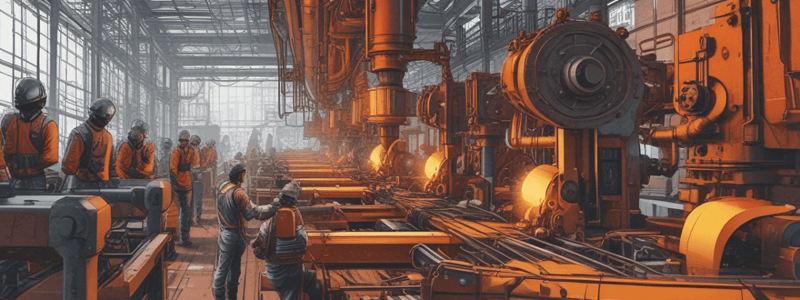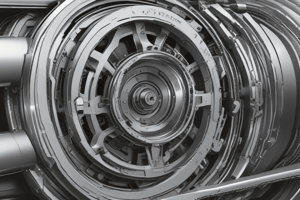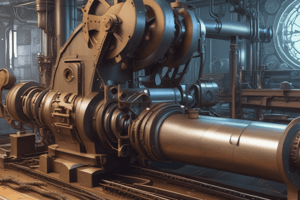Podcast
Questions and Answers
What is the major difference between metal forming processes and metal cutting processes?
What is the major difference between metal forming processes and metal cutting processes?
- Type of materials used
- Amount of material removed (correct)
- Tooling required
- Heat generation during the process
What is the primary objective of machining in the manufacturing process?
What is the primary objective of machining in the manufacturing process?
- To change material composition
- To decrease material density
- To achieve desired dimensions and surface finish (correct)
- To increase material strength
Why is preforming like casting or forging insufficient for engineering components like gears and screws?
Why is preforming like casting or forging insufficient for engineering components like gears and screws?
- It generates excessive heat during the process
- It doesn't provide the desired accuracy and finish (correct)
- It leads to material softening
- It requires specialized tooling
Which term best describes the gradual removal of excess material from a preformed blank to achieve the desired dimensions and surface finish?
Which term best describes the gradual removal of excess material from a preformed blank to achieve the desired dimensions and surface finish?
What characteristic differentiates metal cutting processes from metal forming processes?
What characteristic differentiates metal cutting processes from metal forming processes?
Why do components like gears and bearings require good surface finish?
Why do components like gears and bearings require good surface finish?
What is the primary purpose of machining a work?
What is the primary purpose of machining a work?
What is the function of cutting fluid in machining?
What is the function of cutting fluid in machining?
Which type of machine tool is a vertical axis milling machine classified as?
Which type of machine tool is a vertical axis milling machine classified as?
What is the main difference between non-automatic and automatic machine tools?
What is the main difference between non-automatic and automatic machine tools?
Which classification of machine tools is based on the number of spindles they have?
Which classification of machine tools is based on the number of spindles they have?
What is a salient feature used for specifying a center lathe machine tool?
What is a salient feature used for specifying a center lathe machine tool?
In machining, what are the physical functions of a machine tool?
In machining, what are the physical functions of a machine tool?
What differentiates heavy-duty machine tools from small-duty ones?
What differentiates heavy-duty machine tools from small-duty ones?
What differentiates single spindle lathes from multi spindle lathes?
What differentiates single spindle lathes from multi spindle lathes?
What is the purpose of rake angle in cutting tools?
What is the purpose of rake angle in cutting tools?
Which classification of cutting tools includes milling cutters and hobs?
Which classification of cutting tools includes milling cutters and hobs?
In the Machine Reference System (ASA system), how are the angles of cutting tools expressed?
In the Machine Reference System (ASA system), how are the angles of cutting tools expressed?
What is the main role of clearance angle in cutting tools?
What is the main role of clearance angle in cutting tools?
Why might a cutting tool have a positive rake angle?
Why might a cutting tool have a positive rake angle?
What is the classification of cutting tools that involve drills?
What is the classification of cutting tools that involve drills?
Which system visualizes only the salient features of cutting tools without providing quantitative information?
Which system visualizes only the salient features of cutting tools without providing quantitative information?
In the context of cutting tools, what does the term 'multi-point' refer to?
In the context of cutting tools, what does the term 'multi-point' refer to?
Which type of rake angle design is chosen to increase edge-strength and tool life?
Which type of rake angle design is chosen to increase edge-strength and tool life?
What is the function of clearance angle in cutting tools?
What is the function of clearance angle in cutting tools?
What is the main factor that determines the pattern and extent of total deformation of machining chips?
What is the main factor that determines the pattern and extent of total deformation of machining chips?
Which experimental method involves the study of running chips using a high-speed camera with a low magnification microscope?
Which experimental method involves the study of running chips using a high-speed camera with a low magnification microscope?
What is the mechanism of chip formation generally observed in machining ductile materials?
What is the mechanism of chip formation generally observed in machining ductile materials?
What happens at the sharp crack-tip during machining of brittle materials?
What happens at the sharp crack-tip during machining of brittle materials?
What kind of chips are typically produced when machining ductile materials?
What kind of chips are typically produced when machining ductile materials?
Which parameter is used to quantify the pattern and degree of deformation during chip formation?
Which parameter is used to quantify the pattern and degree of deformation during chip formation?
What does the chip thickness ratio compare in machining processes?
What does the chip thickness ratio compare in machining processes?
In machining ductile materials, what contributes to the increase in chip thickness compared to uncut chip thickness?
In machining ductile materials, what contributes to the increase in chip thickness compared to uncut chip thickness?
Which parameter defines the axial travel of the tool per revolution of the job?
Which parameter defines the axial travel of the tool per revolution of the job?
What characteristic behavior do semi-ductile or semi-brittle materials exhibit under compressive forces at the cutting zone during machining?
What characteristic behavior do semi-ductile or semi-brittle materials exhibit under compressive forces at the cutting zone during machining?
What is the role of the rake angle and friction at the chip-tool interface on chip reduction coefficient?
What is the role of the rake angle and friction at the chip-tool interface on chip reduction coefficient?
How is chip thickening usually expressed in terms of the chip thickness?
How is chip thickening usually expressed in terms of the chip thickness?
What does a larger value of the chip reduction coefficient (rc) indicate?
What does a larger value of the chip reduction coefficient (rc) indicate?
What does equation 1.8 suggest about the relationship between chip velocity (Vf) and cutting velocity (VC)?
What does equation 1.8 suggest about the relationship between chip velocity (Vf) and cutting velocity (VC)?
What is the relationship between shear angle and chip reduction coefficient according to equation 1.10?
What is the relationship between shear angle and chip reduction coefficient according to equation 1.10?
Which parameter affects the value of the cutting strain during machining?
Which parameter affects the value of the cutting strain during machining?
How can chip reduction coefficient be reduced desirably?
How can chip reduction coefficient be reduced desirably?
What happens to shear angle with an increase in tool rake angle?
What happens to shear angle with an increase in tool rake angle?
What type of material favors the formation of continuous chips without Built-Up Edge (BUE) chips?
What type of material favors the formation of continuous chips without Built-Up Edge (BUE) chips?
Which of the following cutting velocities is favorable for the formation of continuous chips?
Which of the following cutting velocities is favorable for the formation of continuous chips?
What type of chips are commonly formed when cutting brittle materials like cast iron?
What type of chips are commonly formed when cutting brittle materials like cast iron?
Which rake angle is conducive to the formation of continuous chips?
Which rake angle is conducive to the formation of continuous chips?
Which cutting fluid type is recommended for the formation of continuous chips?
Which cutting fluid type is recommended for the formation of continuous chips?
In machining, what are segmental chips characterized by?
In machining, what are segmental chips characterized by?
What is chip flow deviation angle denoted by in the text?
What is chip flow deviation angle denoted by in the text?
In pure orthogonal cutting, what angle is typically equal to 900?
In pure orthogonal cutting, what angle is typically equal to 900?
What does BUE stand for in metal machining?
What does BUE stand for in metal machining?
What encourages and accelerates the formation of Built-Up-Edge (BUE)?
What encourages and accelerates the formation of Built-Up-Edge (BUE)?
Why does Built-Up-Edge (BUE) form in machining ductile materials?
Why does Built-Up-Edge (BUE) form in machining ductile materials?
What can happen if the force exerted on Built-Up-Edge (BUE) exceeds its bonding force?
What can happen if the force exerted on Built-Up-Edge (BUE) exceeds its bonding force?
How does high cutting velocity affect Built-Up-Edge (BUE) formation?
How does high cutting velocity affect Built-Up-Edge (BUE) formation?
What harmful effect does Built-Up-Edge (BUE) have on cutting forces?
What harmful effect does Built-Up-Edge (BUE) have on cutting forces?
What kind of chips form in machining when the metal is separated without any discontinuity and moves like a ribbon?
What kind of chips form in machining when the metal is separated without any discontinuity and moves like a ribbon?
What influences the type of chips formed in metal machining?
What influences the type of chips formed in metal machining?
Why does Built-Up-Edge (BUE) formation deteriorate surface finish?
Why does Built-Up-Edge (BUE) formation deteriorate surface finish?
What is the designation (Signature) of a tool geometry with angles 6, 7, 8, 6, 5, 7 and a nose radius of 0.1 in the ASA System?
What is the designation (Signature) of a tool geometry with angles 6, 7, 8, 6, 5, 7 and a nose radius of 0.1 in the ASA System?
Which geometry angle in the ASA System is measured on the machine transverse plane Y?
Which geometry angle in the ASA System is measured on the machine transverse plane Y?
What is the surface against which the chip slides upward in a single point cutting tool?
What is the surface against which the chip slides upward in a single point cutting tool?
In the ASA System for tool geometry, which plane is perpendicular to both the machine longitudinal plane X and the reference plane R?
In the ASA System for tool geometry, which plane is perpendicular to both the machine longitudinal plane X and the reference plane R?
What does the term 'shank' refer to in relation to a single point cutting tool?
What does the term 'shank' refer to in relation to a single point cutting tool?
Which angle provides strengthening to the tool nose and better surface finish in a single point cutting tool?
Which angle provides strengthening to the tool nose and better surface finish in a single point cutting tool?
What is the role of an inclination angle in relation to the direction of chip flow in metal cutting processes?
What is the role of an inclination angle in relation to the direction of chip flow in metal cutting processes?
Which type of metal cutting process involves only two forces and simpler analysis?
Which type of metal cutting process involves only two forces and simpler analysis?
'Auxiliary flank' is associated with which surface in a single point cutting tool?
'Auxiliary flank' is associated with which surface in a single point cutting tool?
Flashcards are hidden until you start studying
Study Notes
Theory of Metal Cutting
- Metal cutting is a process of gradual removal of excess material from the preformed blanks in the form of chips with the help of cutting tools moved past the work surface(s).
- The purpose of machining is to impart required dimensional and form accuracy and surface finish to enable the product to fulfill its basic functional requirements, provide better or improved performance, and render long service life.
Types of Cutting Tools
- Cutting tools can be classified according to the number of major cutting edges (points) involved:
- Single point: e.g., turning tools, shaping, planning, and slotting tools, and boring tools.
- Double (two) point: e.g., drills.
- Multipoint (more than two): e.g., milling cutters, broaching tools, hobs, gear shaping cutters, etc.
Geometry of Single Point Cutting Tools
- The concept of rake angle and clearance angle will be clear from some simple operations:
- Rake angle: Angle of inclination of rake surface from the reference plane.
- Clearance angle: Angle of inclination of clearance or flank surface from the finished surface.
- Rake angle may be positive, zero, or negative, depending on the machining operation.
- Clearance angle is essentially provided to avoid rubbing of the tool (flank) with the machined surface.
Systems of Description of Tool Geometry
- Tool-in-Hand System: Only the salient features of the cutting tool point are identified or visualized.
- Machine Reference System (ASA system): The geometry of a cutting tool refers mainly to its several angles or slopes of its salient working surfaces and cutting edges.
- Tool Reference System: Orthogonal Rake System (ORS) and Normal Rake System (NRS).
- Work Reference System (WRS): The planes and axes used for expressing tool geometry in ASA system for turning operation.
Mechanism of Chip Formation
- In machining ductile materials, the chip forms through a process of gradual compression, shear deformation, and slip.
- Piispannen's model explains chip formation using a card analogy.
- The geometry of chip formation is influenced by:
- Work material
- Material and geometry of the cutting tool
- Levels of cutting velocity and feed
- Machining environment or cutting fluid
- Machining of ductile materials generally produces flat, curved, or coiled continuous chips.
Chip Thickness Ratio
- Geometry and characteristics of chip forms are assessed and expressed by some factors, the values of which indicate about the forces and energy required for a particular machining work.
- The chip thickness ratio (a2/a1) is a significant parameter in chip formation.
- The reasons for the chip thickness ratio being greater than unity are:
- Compression of the chip ahead of the tool
- Frictional resistance to chip flow
- Lamellar sliding according to Piispannen### Chip Reduction Coefficient
- The chip reduction coefficient (rc) is the ratio of chip thickness after cutting (a2) to chip thickness before cutting (a1)
- rc = a2 / a1
- Larger values of rc indicate more thickening, requiring more force or energy to accomplish machining
- Desirable to reduce rc without sacrificing productivity (metal removal rate, MRR)
Factors Affecting Chip Reduction Coefficient
- Tool rake angle: larger positive rake angle reduces rc
- Chip-tool interaction: reducing friction by using a lubricant reduces rc
- Equation 1.4: rc = cos(β - γ) / sinβ
Shear Angle
- Shear angle (β) is the angle of inclination of the shear plane from the direction of cutting velocity
- β depends on:
- Chip thickness before and after cutting (rc)
- Rake angle (γ)
- Equation 1.10: tanβ = cos / rc - sin
- Equation 1.11: tanβ = rcos / 1 - rsin
- Increasing rc decreases shear angle, and vice-versa
Cutting Strain
- Cutting strain (ε) is the magnitude of strain that develops along the shear plane due to machining
- Equation 1.12: ε = cotβ + tan(β - γ)
ASA System for Tool Geometry
- The ASA system is used to define tool geometry
- Axes: R, X, Y, Xm, Ym, Zm
- Planes: Reference plane (R), Machine longitudinal plane (X), Machine transverse plane (Y)
- Geometrical features and angles:
- Shank: portion of the tool bit not ground to form cutting edges
- Face: surface against which the chip slides upward
- Flank: surface that faces the work piece
- Heel: lowest portion of the side cutting edges
- Nose radius: conjunction of the side cutting edge and end cutting edge
- Base: underside of the shank
- Rake angles: side rake angle (x), back rake angle (y)
- Clearance angles: side clearance angle (ax), back clearance angle (ay)
- Cutting angles: side cutting edge angle (fs), end cutting edge angle (fe)
Designation of Tool Geometry
- Tool geometry is designated by a series of values of the salient angles and nose radius
- Example: y, x, ay, ax, fe, fs, r (in inch)
Types of Metal Cutting Processes
- Orthogonal cutting process: cutting edge or face of the tool is 90° to the line of action or path of the tool
- Oblique cutting process: cutting edge or face of the tool is inclined at an angle less than 90° to the line of action or path of the tool
Built-up-Edge (BUE) Formation
- Causes of BUE formation:
- High stress and temperature at the chip-tool interface
- Mutual affinity or solubility of the chip-tool materials
- Characteristics of BUE:
- Shape, size, and bond strength
- Depend on work-tool materials, stress, and temperature
- Effects of BUE formation:
- Unfavorably changes rake angle at the tool tip
- Increases cutting forces and power consumption
- Reduces tool life
- Deteriorates surface finish
Types of Chips
- Continuous chips without BUE: formed when the cutting tool moves towards the work piece, and the metal is separated without discontinuity
- Discontinuous chips: formed when the metal is fractured like segments of fragments and passes over the tool faces
- Factors affecting chip formation:
- Type of cut (continuous or intermittent)
- Work material (brittle or ductile)
- Cutting tool geometry (rake, cutting angles)
- Cutting velocity and feed
- Cutting fluid (type and method of application)
Studying That Suits You
Use AI to generate personalized quizzes and flashcards to suit your learning preferences.






